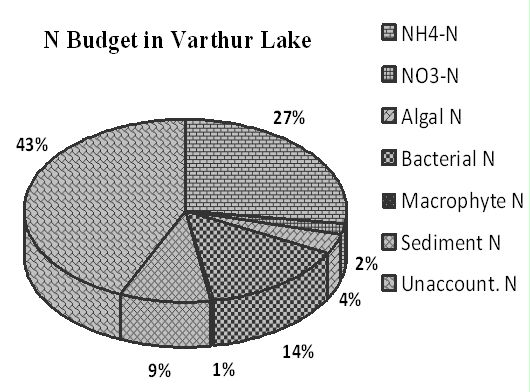1 Centre for Sustainable Technologies,
2 Centre for infrastructure, Sustainable Transportation and Urban Planning,
3 Energy and Wetlands Research Group, Centre for Ecological Sciences, Indian Institute of Science, Bangalore 560 012, India Conclusion An attempt was made to develop an N budget in an urban water body with sewage ingress through mass balance and transformations in various entities of the system. From the findings of this research NH4-N was found to be the predominant Nr form and bacterial uptake and is the major mechanism for nitrogen removal, followed by sedimentation process. Bacterial biomass, algal biomass and macrophyte biomass accounted for 14, 4 and 1% removal (Figure 3), respectively of the N flowing in the lake. Volatilization, denitrification and organic-N mineralization could have been the main process which might have played a significant role in reducing nitrogen from the lake at normal pH levels. Mineralization, ammonia uptake and denitrification processes might be the key nitrogen transformation routes in this lake system which together sum up as unaccounted N. However throughout the study no significant change or improvement occurred with nitrification process. Ammonia concentration and nitrification accounted for 27% and 2%, respectively as shown in Figure 3. While bacterial uptake remained fairly constant throughout the year, micro-algae was the major player during monsoon and winter and macrophytes dominated Nr capture during summer among autotrophs. From the estimates it has been observed that nearly 55% Nr was recovered, recycled as cell mass and transferred to a crop system when such a N-captured water is used for irrigating fodder crops. About 45% (Figure 3) of N input into the system was lost and methods to reduce this loss need to be evolved in the future. Under conventional water treatment systems involving a denitrification step, all N would be lost forever and such a process is suggestive of a reasonably high potential for sustainable N (and other nutrient) recycling These findings creates new challenges for creating efficient N recovery systems from sewage and urban wastewater for the future.
Citation: Durga Madhab Mahapatra, Chanakya H. N and T. V. Ramachandra, 2010, NR Budget and sustainable n-recovery in a sewage fed urban waterbody – case study of Varthur lake, Bangalore. Proceedings of the 5th International Nitrogen Conference on Reactive N Management for Sustainable Development - Science, Technology and Policy, 3-7 December 2010, New Delhi, India.
|
||||||||||||||||||||


